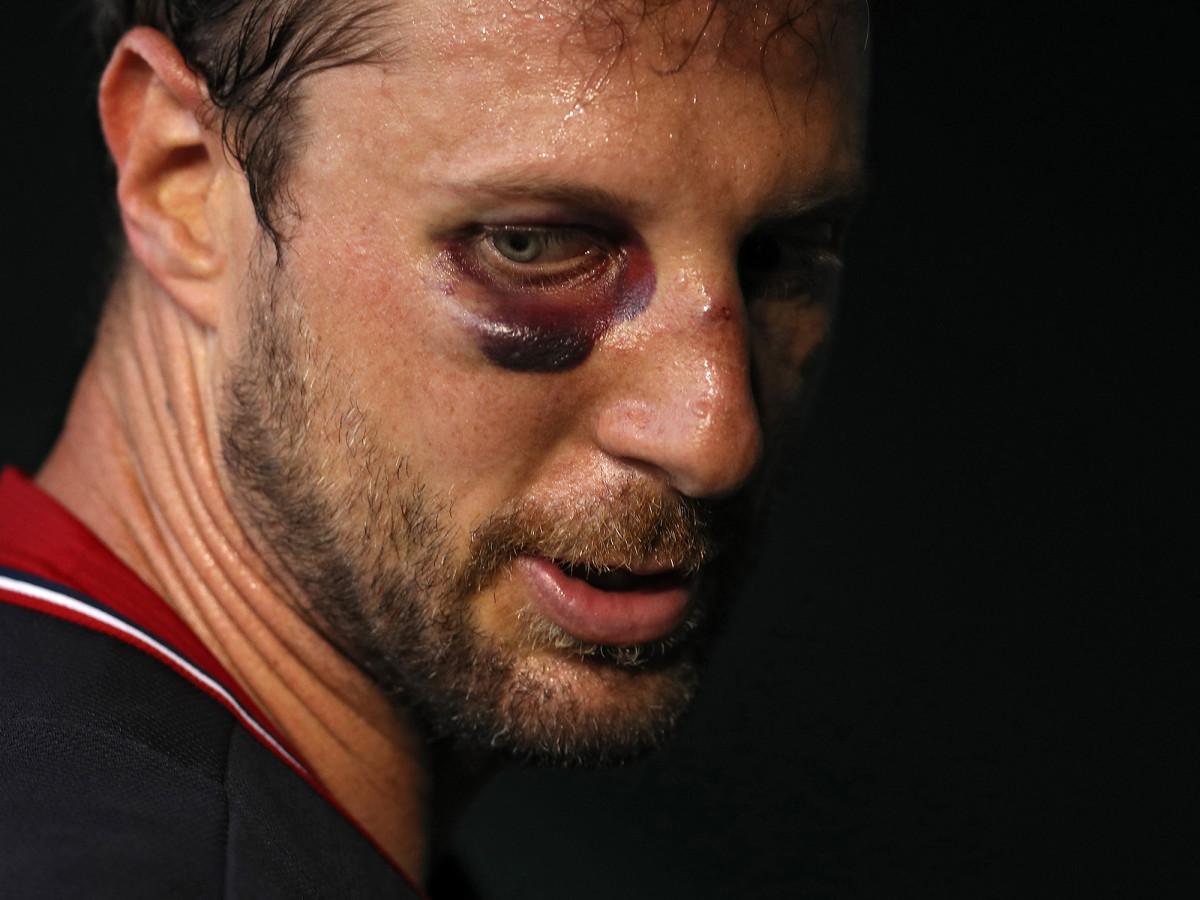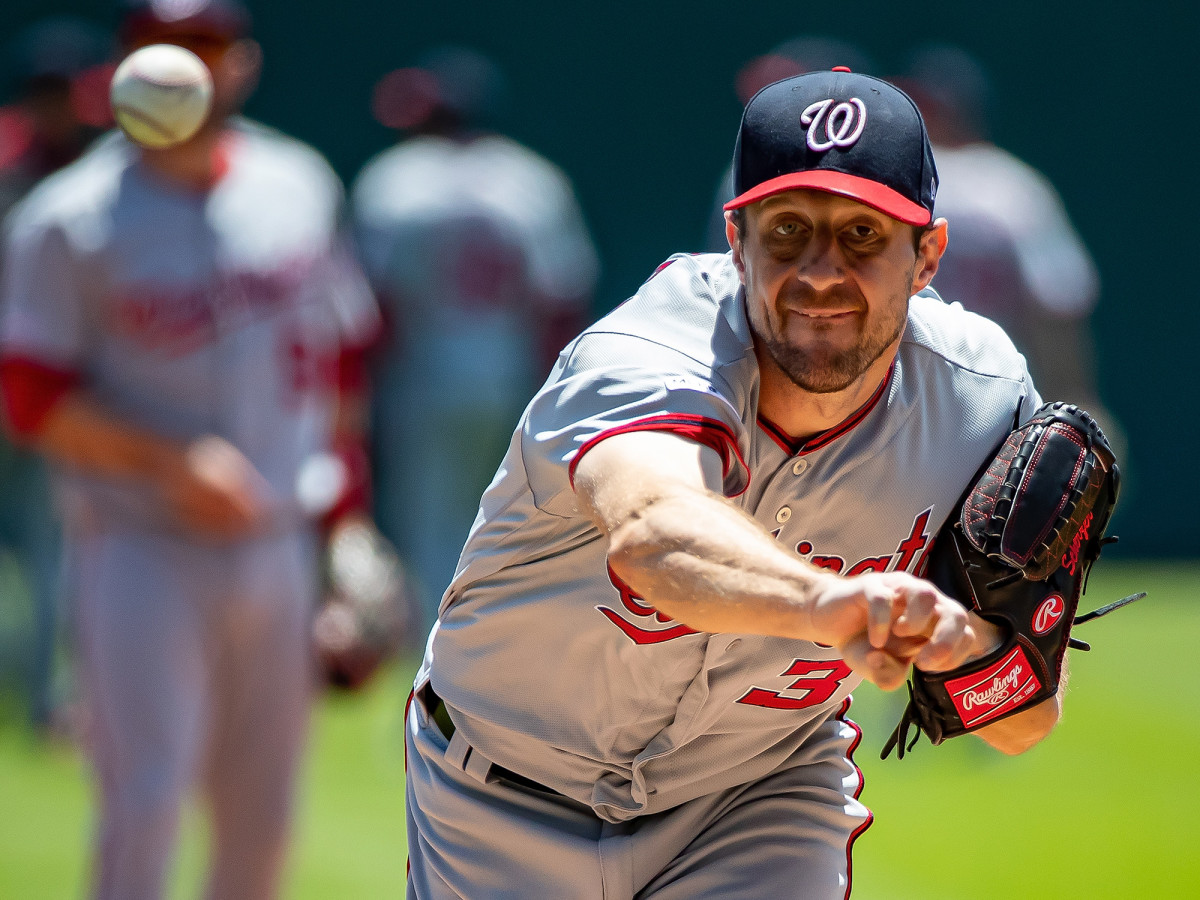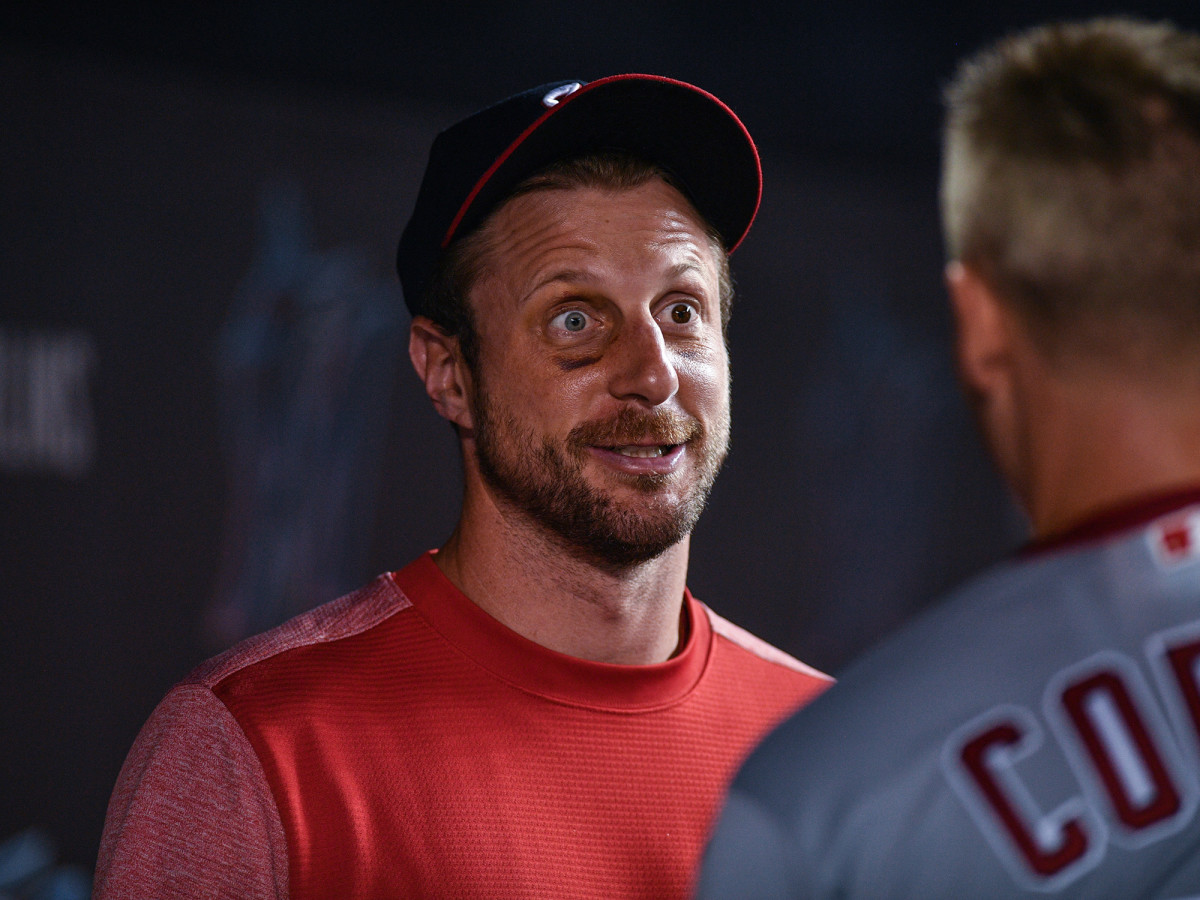The Rare Greatness of Max Scherzer Has Never Been More Evident

DETROIT — On the night Max Scherzer broke his nose while practicing his bunting, he stopped by the office of Washington manager Dave Martinez on his way home.
“I’m pitching tomorrow,” Scherzer insisted.
Martinez waved him off.
“Go home and go to sleep,” Martinez said. “Text me in the morning and tell me how you feel. We can talk about it then.”
Of course Martinez, like the rest of us, figured no way Scherzer was pitching a major league game with a freshly broken nose. Breathing could be a problem. So could the swelling around his eye.
First thing the next morning, Martinez’s phone buzzed with a text from Scherzer. There was a photo attached. The photo was a Scherzer selfie with his right eye surrounded by a puffy sea of dark purple, the color of eggplant.
The text said, “I’m good to go!”
And so Scherzer not only took the ball, he also threw seven shutout innings, struck out 10 and threw as hard as he ever has in the past seven years, averaging 96.2 mph on his fastball.
Scherzer always did have a great game face. The way he stalks around the mound in that leonine prance … tugging his cap hard down on his head … meeting the throw from the catcher as if he can’t wait to throw the next pitch by the batter … the fast pirouette and primal burst from deep in his lungs upon the third out to snuff out a rally … all of it are his unmistakable imprimaturs of greatness.
But the night of June 19 gave us the unforgettable image that will stand as the physical embodiment of the man’s enormous will: Scherzer peering over his glove, as if staring through the very soul of a hitter with menace in his heart, with eyes of three colors: blue, brown, and his fresh purple badge of courage.

What you must understand is that this night happened in what is the greatest month of pitching in the extraordinary career of Scherzer. It is even bigger than that. It is a month of pitching that ranks among the best ever crafted.
Just weeks from turning 35 years old, in a game gone crazy with a more aerodynamic baseball leaving the yard like never before, Scherzer is throwing like never before … like Martinez has never seen.
“This month is the best I’ve ever seen him,” Martinez said. “It’s the best I’ve ever seen. Period. From anyone. The guy was out there with a broken nose throwing 98.”
Scherzer capped the month with a 2-1 win over Detroit on Sunday in which he allowed no walks and four hits while striking out 14 over eight innings.
In six starts in June Scherzer was 6-0 with a 1.00 ERA with 68 strikeouts in 45 innings. It was an all-time great month. He became only the fourth man ever to strike out so many batters in an undefeated month. The others: Nolan Ryan (September 1973), Roger Clemens (July 1988 and August 1998) and Pedro Martinez (May and September 1999).
And here’s the best part: Scherzer has evolved with the game and pushed his body to throw the baseball like he never did before. Though he has retained every bit of his velocity, he has become a master technician on the mound. He threw just 41% fastballs Sunday against the Tigers, the second lowest among his 347 career starts, according to Pitch F/X data. Not once among 115 pitches did he throw four fastballs in a row.
When asked if this was his best month ever, Scherzer thought for a moment and replied, “The answer is yes … because you’re always trying to do something more with the baseball. You’re always trying to further your game. And right now I feel like I’m getting in midseason form where I understand my mechanics and where I’m at. I understand what I’m trying to do with the baseball with all my pitches and have them be sharp and consistent.
“There’s been different times in different games where I’ll have a couple of the off-speed pitches going and a couple that are not quite up to par. I really feel like I’ve gotten to the point where I understand what I need to do with each pitch and what I need to practice on in between each start to make sure I have separation between all of them and to make sure I am consistent every time out.”
When Scherzer began taking a regular turn in the big leagues, he poured in 70% fastballs. The rules of engagement back then, in 2009, required pitchers to establish their fastball down and away. Everything worked off that pitch. That’s what Scherzer learned as “the right way” to pitch.
Today less than half of the pitches Scherzer throws are fastballs, a methodology he began to embrace in 2017. Fastball usage across the big leagues has shrunk nearly every year for the past five years and is down to 51% now. Scherzer throws just as hard as he did 10 years ago, but he uses velocity much less.
In his first nine seasons Scherzer threw 59% fastballs, and hitters batted .241 against the pitch and .232 overall. In the past three seasons, he has reduced his fastball use to 48%, and held batters to a .213 average with the pitch and .192 overall.

So I asked him, is the decline in fastball usage more about how he has changed, how the game has changed, or how swings have changed to get the ball in the air more?
“It’s everything,” he said. “I don’t think you can peg it down to one point. All I know is that the low fastball is getting crushed. That’s why I love being in the NL. Because you’re in the batting cages and you see the hitting coaches working with the guys and what they’re trying to do with the baseball and how they craft their swings and you start hearing their lingo and you start understanding what they’re trying to do with the bat and the way they want to hit the ball in different spots. It all makes sense what’s going on on the field.”
The most overrated narrative in the past few years is how velocity is responsible for depressing batting average and increasing strikeouts. Hitters adjusted to velocity years ago. The far bigger change is that pitchers are spinning the ball more than ever before. Slider use has increased every year since 2015, from 14.5% to 18.1%.
Scherzer is the pitcher best equipped to leverage this new way of pitching with fewer fastballs. That’s because he works diligently at maintaining the unique speed and shape of his four “secondary” pitches (slider, curve, cutter and change) rather than have any two morph into one breaking ball that is neither fish nor fowl.
Over the past four years he has replaced some of his fastball use by adding a cutter in 2016 and by boosting his slider use in 2017. Those close to him said he is working toward reducing his fastball use to 45%.
Said Scherzer when asked about that objective, “I wouldn’t say I have any goals of where I want to get the pitches to. Because my pitching sequencing isn’t based on a goal. I’m not coming in saying, ‘I want to throw 45% fastballs.’ I’m basing my sequencing off my opponents.
“I look at how the other team hits against a slider, for example. I look at that and think is that something I should be throwing more of or less of? It’s real individualized on a start to start basis.”
Few pitchers have so many weapons. Fewer still have the pitching intellect to maximize their use. Here is a look at what Scherzer can do with a baseball:
Fastball: When he throws it at least 2 ½ feet off the ground (roughly from mid-strike zone up), batters hit .160 off his fastball. With its high spin rate (sixth best in baseball) that creates ride, it’s the perfect anti-aircraft pitch in today’s Launch Angle game. Across MLB, batters hit .242 against all fastballs that high and .301 when they are lower.
Changeup: He throws it off his ring and pinkie fingers, with his thumb pushing the ball out of his hand to created fade. Scherzer has such a deft touch on the pitch that his changeup is among the 10 lowest spinning changeups in baseball (1,551 RPMs; less spin is better for a changeup because it deadens the ball to allow more drop).
Max Scherzer, Disappearing 84mph Changeup. 👻 pic.twitter.com/yR7Rr1vxSG
— Rob Friedman (@PitchingNinja) June 30, 2019
Cutter: He invented the pitch to find a way to get out Joe Mauer. He wanted a pitch to neutralize lefthanded hitters on the inside part of the plate. The cutter has more horizontal movement and more velocity than the slider, making it ideal for that purpose.
Slider: He has thrown 418 sliders this year and allowed only four extra-base hits with it. This pitch is how you combat slugging in today’s game, not with velocity.
Max Scherzer, Filthy 87mph Slider. 😷 pic.twitter.com/7JxwPaClXm
— Rob Friedman (@PitchingNinja) June 30, 2019
Curveball: This is practically a free strike. Hitters take the pitch almost 70% of the time. He has allowed only six hits all year on the pitch. Scherzer maintains a 7.3 mph average difference between his slider and curveball.
There is another important element to what makes Scherzer the most evolved form of pitching today: deception.
“People love to talk about velocity and spin rate,” he said, “but deception is huge. I’m big on deception.”
The way in which Scherzer releases the baseball creates deception that makes hitters uncomfortable. Scherzer lets go of the ball 3.51 feet offset from the middle of the rubber (toward third base), creating an extreme angle hitters just don’t see. Scherzer’s offset is the greatest of any starting pitcher in baseball.
Moreover, because he uses his legs so well and has a low release point, the ball is only a bit more than five feet off the ground when he lets it go, placing him among the seven starting pitchers with the lowest release point in baseball. Fastballs thrown from a low release point to the high part of the strike zone are death to Launch Angle swings.
Scherzer pitches like a kid in a snowball fight, crouched and throwing from behind the corner of a building. Now imagine not snowballs coming at you but baseballs that travel anywhere from 75 mph to 98 mph, and they might ride, sink, cut, tilt or drop. Now you only begin to see the difficulty of solving Scherzer.
To beat Scherzer you have to triumph over not just his stuff and his deception but also his will. When the Nationals are home, you might see Scherzer running long distances in the area of the Washington monuments, one of the three days in between starts when he runs (one day for distance, one for intervals, one for sprints). As an American League pitcher, Scherzer would take a “flush run” the day after starts. Since joining the Nationals, he has increased his running, and his explanation is pure Scherzer.

“I always find ways to do more, to push the limits,” he said. “And I listen to my body. It’s not like I run myself into the ground to the point where it takes away on the mound.
“There are times I can push more. There are times when I have to back off. For me it’s always finding a way to do more.
“Honestly, we always did flush running in the AL. In the NL, when you have to run the bases and pitch, and you run into a start where you have to run the bases in a tie ballgame and it means something to score that run, then it’s ‘Hey, now we need you to throw that shutdown inning.’ You have to have some cardio in you.
“So when you get into those types of ballgame I feel like I owe it to my teammates to be in the best shape possible to run the bases just like they would. Just because I’m a pitcher doesn’t mean I can’t take an extra base or score a run to help us win.
“But if I’m going to do that I’m also going to need the cardio to go back out there and pitch to my level–what I expect to pitch at. That why I got into more cardio-based training here in the NL.”
Max Scherzer has thrown more pitches since 2009 than any pitcher except Justin Verlander. Here he is about to turn 35 and is still such a competitor that he asked Martinez to tailor the Washington rotation to make sure he is available to pitch in the All-Star Game next week. On Sunday he threw 115 pitches for a fourth time this year, more than all the pitchers his age or older combined. Detroit did not put in play any of his final 19 pitches, going out strikeout-strikeout-strikeout-strikeout against one of the game’s great finishers. The hardest fastball he threw all afternoon was his last: 97.6 mph.
Max Scherzer's 14 Strikeouts in 26 Seconds. 😳 #NSFW pic.twitter.com/l6J17hRZeH
— Rob Friedman (@PitchingNinja) June 30, 2019
“I learn more about myself and pitching in the last 15 pitches than I do in the first 100,” he said. “You learn what you need to do to execute a perfect slider when you push up against fatigue.”
He is throwing fewer fastballs than ever. And yet he is better than ever. He is confounding hitters and the normal arc of a pitching career in this era.
Scherzer sometimes is known by the nickname “Mad Max” because, well, a movie happened to be made once with that alliterative title, and, to a lesser degree, the visage he strikes on the mound is full of fire and fury.
But we are missing the essence of Scherzer with that shorthand. For Max Scherzer is a pitcher’s pitcher, a surgeon with a baseball who, nearing 35, not only has kept his stuff but also has made it better. This is the state of the art of pitching. And if we can pull ourselves away for a moment from the monsoon of home runs and the aerodynamics and conspiracies associated with the baseball, we just might appreciate the rare greatness of Scherzer.
